Minds On
All about bees
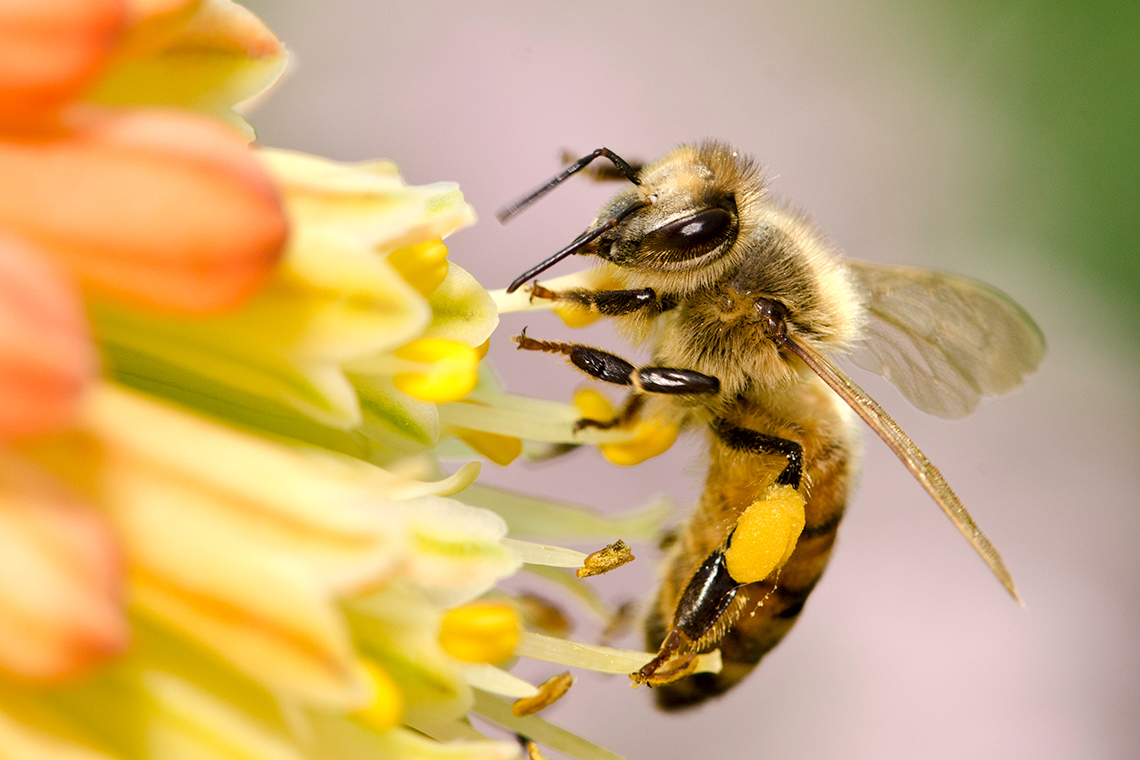
What’s all the buzz about bees? Why are farmers, environmentalists, and scientists so concerned about them?
How much do you know about bees? Do you know what role do they play in our environment, why they are so important, and why there is increasing concern over their populations?
Complete the first two columns of the following Know, Wonder, Learn Chart in your notebook or using the following fillable and printable document. If you would like, you can use speech-to-text or audio recording tools to record your thoughts.
Explore the following video clip from “TVOK News” about the role of bees in our world.
Revisit your Know, Wonder, Learn Chart and complete the last column with notes on anything you may have learned about bees after exploring the video. Did any new wonderings come up? If so, add them to the “Wonder” column of your chart.
Action
Bee diversity
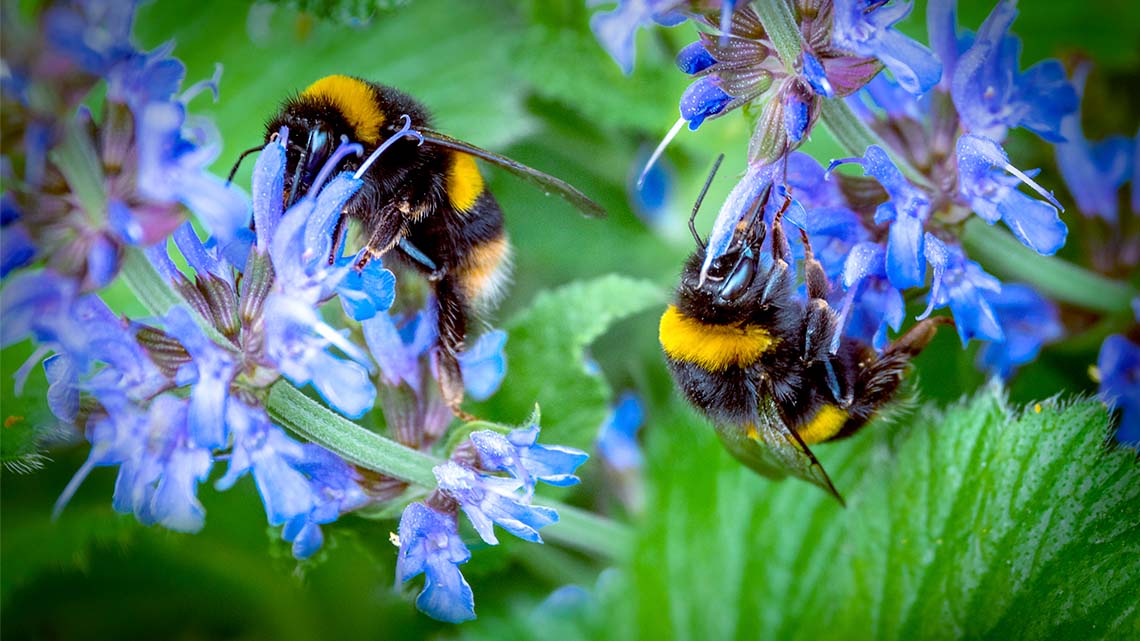
There are over 850 different native species of bees in Canada. Ontario alone has about 400 species of wild bees, and new bee species are still being discovered on a regular basis!
The term “native species” refers to a group of organisms that originated in a specific ecosystem or land area. In other words, they are indigenous to that habitat. They are naturally occurring and, historically, have been self-sustaining.
“Wild bees” refers to bees that are found in natural habitats and not human-made ones such as commercial or hobby bee farms.
Test your bee knowledge
Typically, when we think of bees, we think of fuzzy, black and yellow bumblebees, but bees actually come in many different colours, shapes and sizes! Biodiversity in bees is quite large and is incredibly important as different species of bees live in varied habitats, perform different roles in our ecosystem, and can fight off different types of threats more easily.
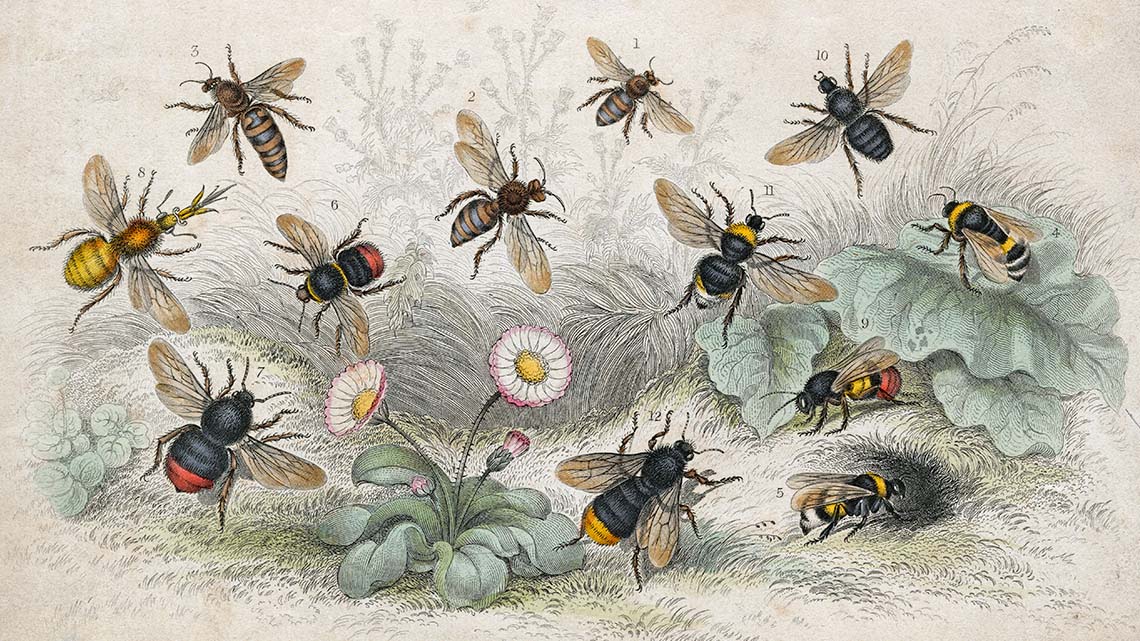
An illustration of different species of bees showing their diversity. Some have longer bodies than others, some have slimmer bodies than other. Some are yellow and black, others have red or orange on their rear ends. Some have an obvious second set of smaller wings and others appear to only have one set of wings.
One of the most surprising facts about bees is that not even one of Canada’s native bees makes honey (Colla & Nalepa, 2019)!
Did You Know?
Did you know?
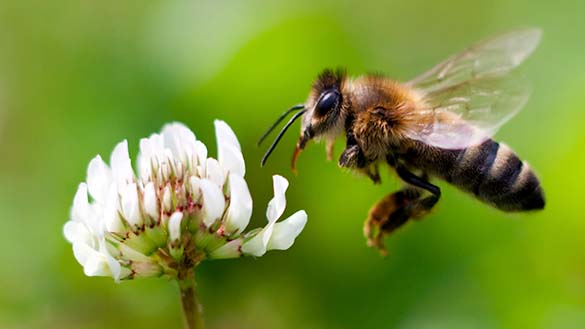
A honeybee looking for nectar.
Honeybees are not a native species to Canada. They were brought to North America from Europe sometime in the 1600s. They are widely used to produce honey and other products like wax and, because they live in large social colonies, honeybees are great at helping to pollinate large farms (farmers often rent bees at certain periods of time to help pollinate their crops).
Over the years, both commercial and hobby beekeeping has become quite common and, as a result, some people can consider honeybees to be an invasive species. But they’re helping to pollinate plants and flowers, so how can this be? There are a few reasons behind this argument:
- The large volumes of non-native honeybees are actually competing with native bees for the same sources of food and their large numbers mean that the native bees often miss out on the nectar and pollen.
- Unlike native bees, honeybees can take nectar from some flowers and not actually take any pollen, meaning less pollination is occurring and fewer fruits and seeds are being produced.
- Honeybees are likely to pollinate non-native plants more than native ones, which decreases the populations of the native plants that are natural food sources for other organisms.
- Honeybees also tend to carry more diseases than other bee species and can pass these along to native bees further threatening their populations’ survival.
There is a lot of debate about this non-native species, the honeybee, and whether overall they help or hinder ecosystems and the native bees of Canada. What’s your opinion and why is it important to have many different species of bee including native species?
Record your thinking using a method of your choice such as in print, digitally or with an audio recording. If possible, share your thinking with a partner.
Bees and pollination
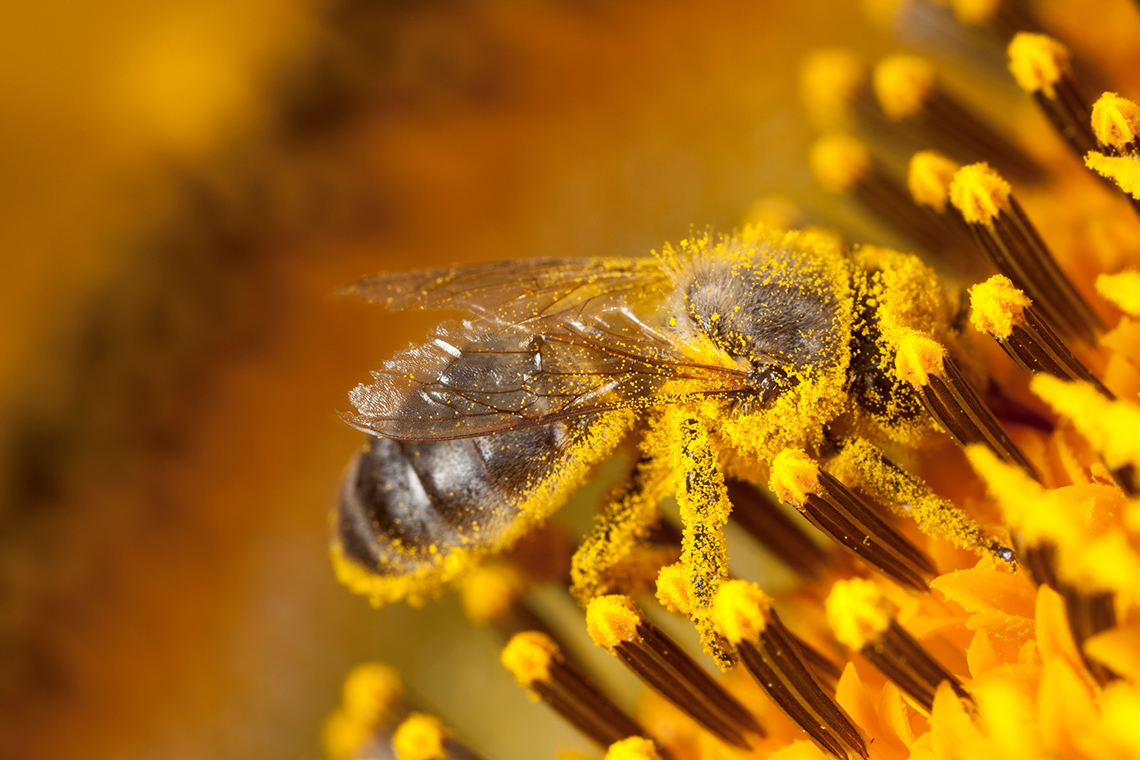
A bee covered in pollen from a sunflower.
Possibly one of a bees’ most famous and important roles is as a pollinator!
While there are many other pollinators such as butterflies, moths, wasps, flies, some types of beetles, hummingbirds, and even certain bats, the large diversity of bee species means that they contribute a significant amount to pollination. Pollination is crucial to many crops and to our global ecosystem.
How does pollination work exactly? As bees fly, they build up static electricity.
Static electricity is the build-up of an unbalanced electrical charge on the surface of an object. Since opposite charges attract, the built-up, “static” charge seeks an opposite charge to balance itself out.

A bee flying up to a flower. Surrounding the bee are positive electrical charges. Surrounding the flower are negative electrical charges. Opposite charges attract.
When bees fly, friction between their bodies and surrounding air molecules mean that they lose some negative charge, making their bodies more positively charged and therefore unbalanced. This built-up positive electrical charge attracts the naturally negative charge of pollen. Since opposites attract, this means the pollen sticks to the bees!
The pollen is then collected by the bee and packed into sacs on its hind legs. As they visit different flowers, pollen from one flower transfers to another flower and cross-pollination occurs!
Cross-pollination is the transfer of pollen from one plant to another. This can trigger a reaction in the flower and is how plants are pollinated to produce fruits, vegetables, legumes and new plants.
Investigate
Bees and static electricity
Let’s investigate and explore the following demonstration of how static electricity works with bees and pollen. If possible, try conducting the experiment yourself!
Press the following tabs to access a list of materials needed, the procedure, and the video demonstration.
- small, lightweight material, such as a piece of paper ripped into small pieces, confetti, or salt.
- flannel or wool fabric (a clothing item made of these materials, for instance).
- a plastic or rubber object, like a ruler or a blown-up balloon.
- First, spread the light-weight material out on a flat surface.
- Next, rub the plastic or rubber object with the flannel or wool fabric to build up its electrical charge.
- Then, slowly bring the plastic or rubber object close to the spread-out material. What happens?
Explore the following video demonstration of the experiment.
What do you think?
Which object in the experiment is like the bee, and which is like the pollen of the flower?
Record your explanation using a method of your choice such as in print, digitally or using an audio recording.
Climate action and bee populations
Global connection
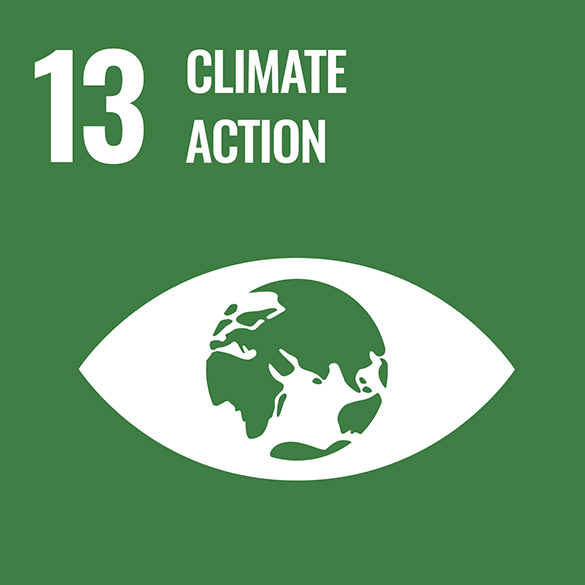
The United Nations (UN) is a group of many countries from around the world that have come together to create a better future for people and the environment. They have created 17 goals called the Sustainable Development Goals.
This learning activity is connected to Goal #13: Climate Action. This means everyone should help reduce climate change and its impact. Storms, disasters, and lack of food and water are made worse by climate change.
Many bee species are being greatly impacted by climate change as well as other factors.
As you explore the following content to learn more about what is threatening domestic bee populations, make a detailed list of the threats and how bees are affected. This could be in the form of a cause-and-effect chart.
Complete the Cause-and-Effect Chart in your notebook or using the following fillable and printable document. If you would like, you can use speech-to-text or audio recording tools to record your thoughts.
|
Cause (threat to bees) |
Effect (describe the effect of the threat on bees) |
|---|---|
Press the ‘Activity’ button to access Cause-and-Effect Chart.
Press the following tabs to access information on the decline of bee populations in Canada and around the world.
One of the most commonly discussed reasons for a decline in bee populations is due to pesticide use on lawns and crops of fruits and vegetables. When the bees feed on plants with pesticides, these toxins build up in their systems and can cause sickness and death.
Hotter temperatures, drought in some areas and more severe weather have impacted the growth and habitats of many flowers. There are fewer flowers than there used to be in some areas of our planet. Bees are healthiest when they feed on different species of plants. Because of the loss of habitats, bees are getting less choices in their diet and are not flourishing as they once used to.
Because of climate change, hotter temperatures, more severe weather and lack of food mean an increase in diseases, viruses and infections. Introduction of non-native species of plants and other organisms, including invasive species, also mean new viruses being introduced to bee populations.
More severe weather and storms due to climate change mean significantly wetter soils increasing the threat of drowning to bee species that burrow in the ground or in fallen plant debris.
Hotter temperatures also due to climate change mean that some bee species are having to shift their habitat range in favour of their optimal cooler temperatures. This means that more bees are foraging in smaller areas and competing even more for food sources. Also, other bee species displaced from their own natural habitats due to climate change mean even more competition for food for native bees.
Reading Time
Declining bee populations
Access the article “Give bees a chance: Why we can’t afford to lose our wild native pollinators” to continue learning about the different threats to our bee populations and the impacts of these declines.
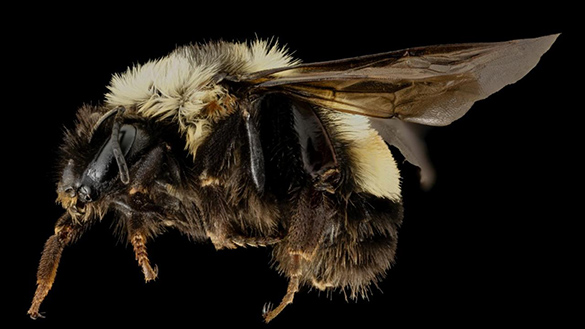
A rusty-patched bumblebee.
Press tvo today to access Give bees a chance: Why we can’t afford to lose our wild native pollinators.
TVO dot org (Opens in a new tab)What further information did you get from the article you just explored about the decline of bees in Ontario? Record your thoughts in your notebook or using another method of your choice.
The importance of biodiversity
Currently, eight native bee species in Canada are listed as species at risk. Bees and their biodiversity are critical to our food system. We must protect them.
When we discuss biodiversity, we think about diversity between species and within a species. Consider the following questions.
- How could the loss of one bee species affect other species of bees?
- How could the loss of one bee species affect species of plants or animals?
- How could the loss of bee species impact agriculture and human life?
Record your ideas using a method of your choice such as in print or digitally. Consider creating one or several diagrams to communicate your thinking.
Consolidation
Could humans cross-pollinate?
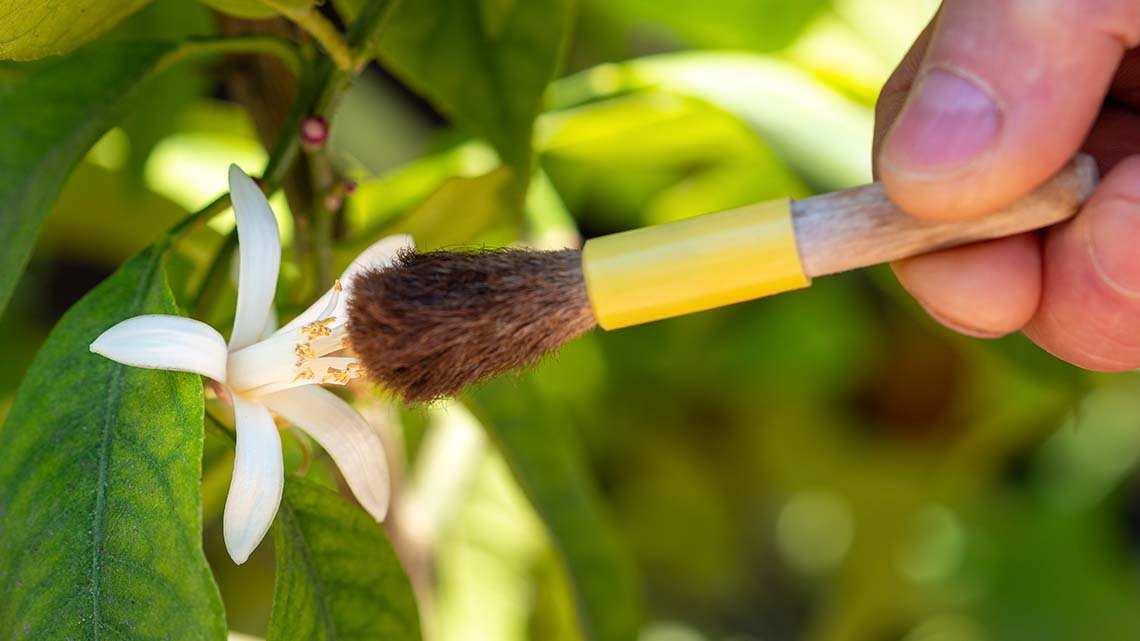
What if there were no bees? Could humans or machines step in to do the critical jobs of these great pollinators?
Can you apply the engineering design process to design a possible machine or device to be used by humans to cross-pollinate flowers and crops?
Before you begin, explore this video to learn about the steps of the Engineering Design Process.
Complete the Design a Cross-Pollination Device Sheet in your notebook or using the following fillable and printable document. If you would like, you can use speech-to-text or audio recording tools to record your thoughts.
|
Ask |
What is the problem you are trying to solve? What if there were no bees? Could humans or machines step in to do the critical jobs of these great pollinators? |
|
Brainstorm |
What are some possible solutions? Brainstorm your ideas in the space provided. Do people pollinate flowers in the world? |
|
Plan |
Plan a design and create a drawing that includes all materials you may need. Can you design clothes, equipment, or another device that could help do the job? |
|
Improve |
Does this solve the problem? A bee visits around 100 flowers per foraging flight. They usually take 10 foraging flights per day and visit 1,000 flowers. That is one bee. The average honeybee colony contains 80 to 100 thousand bees. Approximately 25,000 bees from that colony forage each day. That means one colony of bees interacts with 25 million flowers per day. Do you think humans, or your design are up to the task? Is it reasonable to think that humans can do this work? What changes or conditions could make your design better? |
|
Share |
Share your device with others using a method of your choice. Time to share. Make a commercial or advertisement for your new pollination services company. Convince someone to hire you based on the technology that you have developed. Make sure to use persuasive techniques like a catchy title, slogan, or even a jingle! What impact will your invention make? “Bee” convincing! |
Press the ‘Activity’ button to access Design a Cross-Pollination Device Sheet.
Helping our bees
Revisit the Know, Wonder, Learn Chart that you created in the Minds On section of this learning activity. Is there anything new you might add to the Wonder or Learn columns?
What actions can you take in your life, or what actions can you educate others on, to help save our declining bee populations?
Use the following checklist to help you make an action plan to help bees near you.
Action checklist
To help wild or domesticated bees near me, I could:
Reflection
As you read through these descriptions, which sentence best describes how you are feeling about your understanding of this learning activity? Press the button that is beside this sentence.
I feel…
Now, record your ideas using a voice recorder, speech-to-text, or writing tool.
